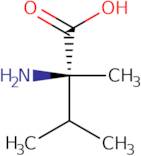(2S)-2-Amino-2,3-dimethylbutanoic acid
CAS: 53940-83-3
Ref. 3D-FM49804
| 1g | Ausgelaufen | ||
| 2g | Ausgelaufen | ||
| 5g | Ausgelaufen | ||
| 250mg | Ausgelaufen | ||
| 500mg | Ausgelaufen |
Produktinformation
- ?-Me-L-Val-OH(S)-(-)-?-Methylvaline
- (2S)-2-ammonio-2,3-dimethylbutanoate
- (S)-2-Amino-2,3-dimethylbutanoic acid
- (S)-2-Methylvaline
- (S)-α-Methylvaline
- 2-Methyl-<span class="text-smallcaps">L</span>-valine
- <span class="text-smallcaps">L</span>-Isovaline, 3-methyl-
- <span class="text-smallcaps">L</span>-Valine, 2-methyl-
- <span class="text-smallcaps">L</span>-α-Methylvaline
- Alpha-Methyl-L-Valine Hydrochloride
- Mehr Synonyme anzeigen
- L-α-Methylvaline
- L-Valine, 2-methyl-
- L-Isovaline, 3-methyl-
- 2-Methyl-L-valine
Norvaline is a small cyclic amine that is an analog of valine. It has been used as a reagent in organic synthesis, as a synthon for peptides, and as the conformationally-restricted component in asymmetric synthesis. Norvaline can be synthesized by reductive cleavage of 1,4-diaminobutane with lithium aluminum hydride. The synthetic route to norvaline begins with vinyllithium, which is then reacted with ammonia to form the corresponding amide. This amide undergoes acid hydrolysis to give norvaline. The amino group on norvaline can be converted to other functional groups through nucleophilic substitution reactions.





